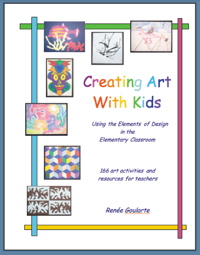In the list of sample activities, and in the book Creating Art With Kids, each group of activities focuses on a specific design element. Several or all activities dealing with one design element should be available to the students at the same time, so they can choose among them. It is not necessary for a child to do every activity. Having these activities available for several weeks gives the children plenty of time to internalize the concepts. During this time, displaying examples of art works which demonstrates use of the element, and telling stories about the artists who created the works, can help reinforce the concepts. Through initial demonstrations of the activities, children can be shown which materials to use and how to proceed. This also gives them introduction to the concept and/or skills presented by the activity. If each activity is first demonstrated to the children, and then all materials for that activity are made available for the children to use on their own, they will have the freedom to work at their own pace. Because the focus of these art activities is on the process of creation, rather than the finished product, it is important that the children be provided ample time and opportunity to experiment. If they are able to choose to do the same work more than once, and given freedom to move beyond the limits of the lessons, they will have the opportunity to express themselves in different ways. A Few Thoughts about Respecting, Appreciating and Displaying Art in the Classroom Children can learn to respect all kinds of art, beginning with the treatment of their own work. Learning to write their names discreetly at the bottom of their work teaches respect for the composition. By taking care to avoid 'helping', or writing comments, including praise, on the children's work, teachers show appreciation for that work. Generally, only the artist should be allowed to touch his work. Encouraging children to talk about their work during sharing or other times shows appreciation for their work, and helps them appreciate the work of others. It can provide an opportunity for discussion about the different elements, focusing on how they are used as well as how they work together to create a composition. Each section of activities has a list of artists whose works illustrate to some degree the use of the design element which is the focus of that section. The children's activities and sharing of their work can be supplemented by talking about these artists and their work. This can facilitate the children's discovery and appreciation of art in general, and the uses of the elements of design specifically. A list of children's books which can be read in the classroom is included whith each group of activities. These books illustrate use of the design elements either through their content or illustrations. Most children enjoy displaying their work. Giving them the choice whether or not to do so gives them control over their artistic expression. Labeling both children's work and art prints with the title of the work and the name of the artist give authenticity to the work. A constantly-changing classroom gallery which exhibits children's work alongside quality art prints serves a variety of purposes. It allows children to get inspiration from other sources. It shows them that a problem can be solved with more than one approach. It allows them to compare and contrast similar and different works. It encourages each child to value his uniqueness. Most of all, it adds joy to the classroom. |
|||
|
